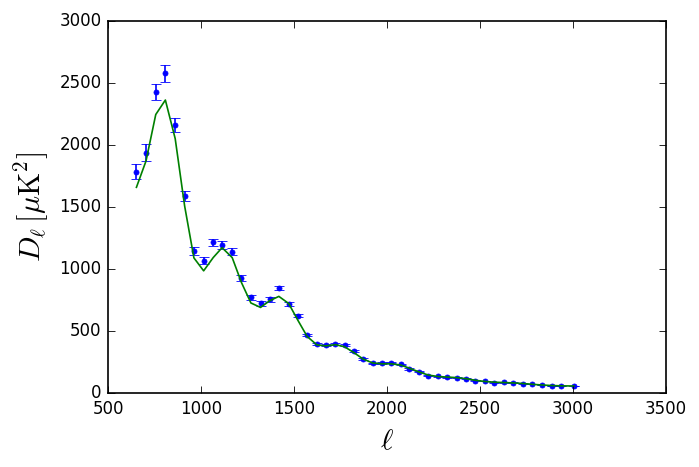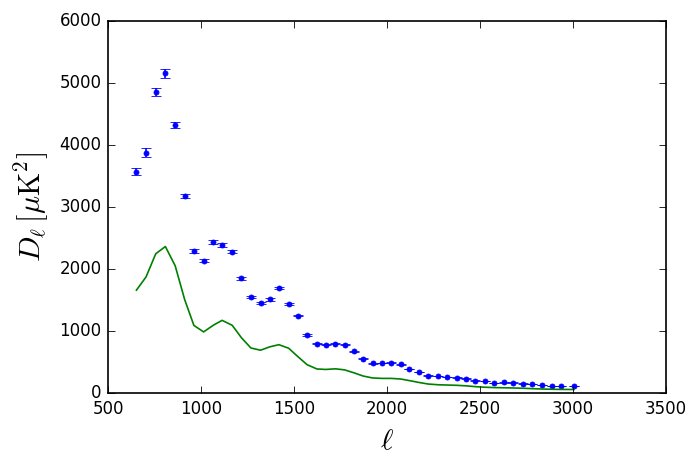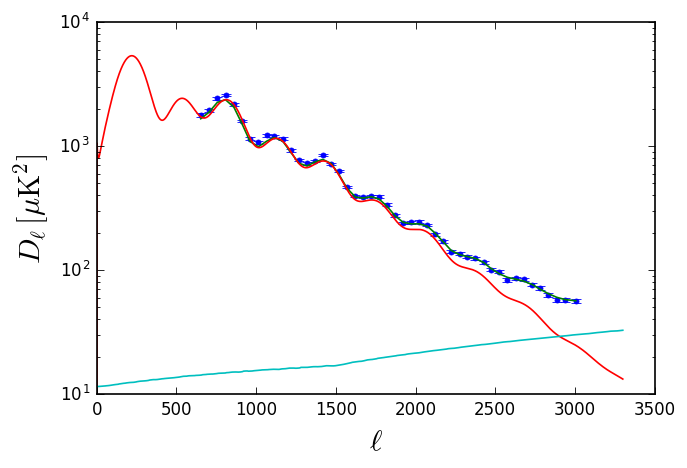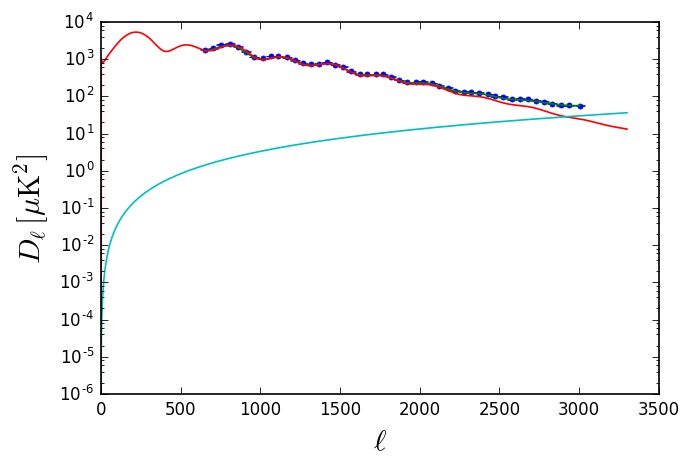South Pole Telescope low-\(\ell\)¶
This plugin implements the South Pole Telescope likelihood from Story et al. (2012) and Keisler et al. (2011). The data comes included with this plugin and was downloaded from here and here, respectively.
You can choose which likelihood to use by specifying which='s12' or
which='k11' when you initialize the plugin.
The plugin also supports specifying an \(\ell_{\rm min}\), \(\ell_{\rm max}\), or dropping certain data bins.
In [1]:
%pylab inline
Populating the interactive namespace from numpy and matplotlib
In [2]:
from cosmoslik import *
Basic Script¶
Here’s a script which runs a basic SPT-only chain:
In [3]:
class spt(SlikPlugin):
def __init__(self, **kwargs):
super().__init__()
self.cosmo = models.cosmology("lcdm")
self.spt_lowl = likelihoods.spt_lowl(**kwargs)
self.cmb = models.camb(lmax=4000)
self.sampler = samplers.metropolis_hastings(self)
def __call__(self):
return self.spt_lowl(self.cmb(**self.cosmo))
Four sampled parameters, one for calibration and three for foregrounds, come by default with the SPT plugin:
In [4]:
spt().spt_lowl.find_sampled().keys()
Out[4]:
odict_keys(['cal', 'egfs.Acl', 'egfs.Aps', 'egfs.Asz'])
The plugin has a convenience method for plotting the data and current model:
In [5]:
s = Slik(spt(which='s12'))
lnl, e = s.evaluate(**s.get_start())
e.spt_lowl.plot()

Or you can plot the “k11” bandpowers. You can see they’re less constraining.
In [6]:
s = Slik(spt(which='k11'))
lnl, e = s.evaluate(**s.get_start())
e.spt_lowl.plot()

Choosing subsets of data¶
You can also set some \(\ell\)-limits,
In [7]:
s = Slik(spt(which='s12',lmin=1000,lmax=1500))
lnl, e = s.evaluate(**s.get_start())
e.spt_lowl.plot()

Or drop some individual data points (by bin index),
In [8]:
s = Slik(spt(which='s12',drop=range(10,15)))
lnl, e = s.evaluate(**s.get_start())
e.spt_lowl.plot()

Calibration parameter¶
The calibration parameter is called cal and defined so it multiplies
the data bandpowers. For “s12” it comes by default with a prior
\(1 \pm 0.026\). You can’t use it for “k11” because this likelihood
has the calibration pre-folded into the covariance.
In [9]:
s = Slik(spt(which='s12',cal=2))
lnl, e = s.evaluate(**s.get_start())
e.spt_lowl.plot()

Foreground model¶
By default the foreground model is the one used in the Story/Keisler et
al. papers (same for both). There’s an option to plot which shows
you the CMB and foreground components separately so you can see it.
In [10]:
s = Slik(spt(which='s12'))
lnl, e = s.evaluate(**s.get_start())
e.spt_lowl.plot(show_comps=True)
yscale('log')

The foreground model is taken from the spt_lowl.egfs attribute which
is expected to be a function which can be called with parameters
lmax to specify the length of the array returned, and egfs_specs
which provides some info about frequencies/fluxcut of the SPT bandpowers
for more advanced foreground models. You can customize this by attaching
your own callable function to spt_lowl.egfs when you call
__init__, or passing something in during __call__.
For example, say we wanted a Poisson-only foreground model, we could write the script like so:
In [11]:
class spt_myfgs(SlikPlugin):
def __init__(self):
super().__init__()
self.cosmo = models.cosmology("lcdm")
self.spt_lowl = likelihoods.spt_lowl(egfs=None) #turn off default model & params
self.Aps = param(start=30, scale=10, min=0) #add our own sampled parameter here
self.cmb = models.camb(lmax=4000)
self.sampler = samplers.metropolis_hastings(self)
def __call__(self):
return self.spt_lowl(self.cmb(**self.cosmo),
egfs=lambda lmax,**_: self.Aps * (arange(lmax)/3000.)**2) #compute our foregroud model
In [12]:
s = Slik(spt_myfgs())
lnl, e = s.evaluate(**s.get_start())
e.spt_lowl.plot(show_comps=True)
yscale("log")
